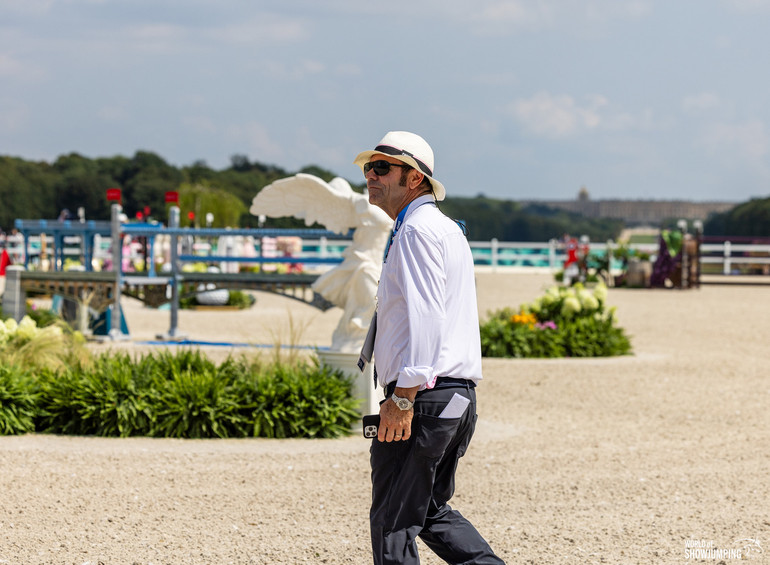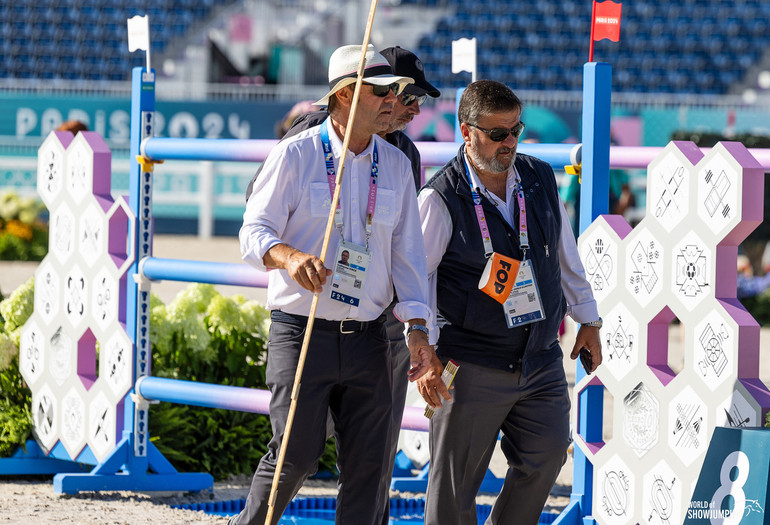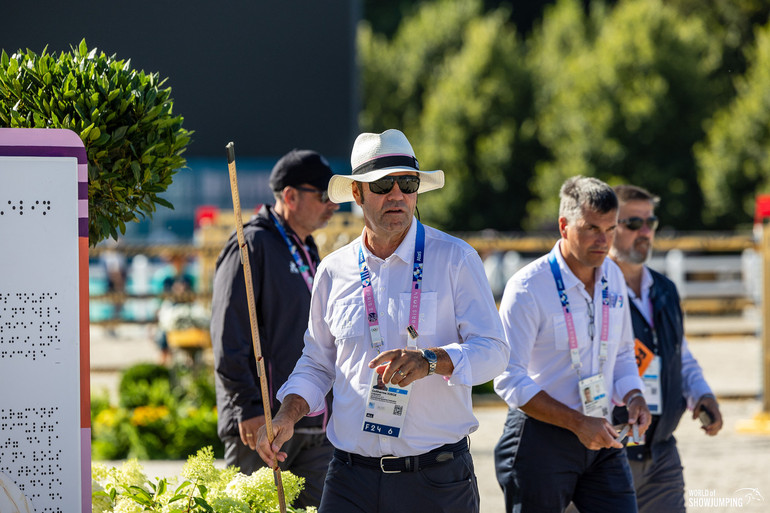Text © World of Showjumping
“I like to joke that when everything goes well, that is the merit of everyone else, but if something goes wrong, that is the technical delegate’s responsibility,” Guilherme Jorge – a FEI level four course designer – tells World of Showjumping about the role he played at the 2024 Olympic Games in Paris.
After being an assistant course designer in Atlanta in 1996, a FEI steward in Sydney in 2000, an assistant course designer in both Athens in 2004 and in London in 2012, and the head course designer in Rio de Janeiro in 2016, the 57-year-old Brazilian experienced his sixth Olympic Games in Versailles – this time as the FEI Technical Delegate.
“The FEI Technical Delegate is a representative of the FEI, someone who needs to make sure that everything runs according to the rules and requirements,” Jorge explains. “A technical delegate does a lot of work in the background and one of the main responsibilities is to work closely with the course designers to make sure that the tracks are appropriate. However, the role also includes supervising the whole venue from the stabling to the conditions for the grooms; it pretty much means keeping an overall look on the whole operation. As the level of the sport is growing, so is the demand on the quality of the installations.”
From veterinary school to course design
Jorge started riding at the age of 10 in his hometown Campinas in Brazil and kept it going up to junior level. “Then I studied veterinary medicine and started working as a vet for showjumping horses,” he tells about his background. “I ended up practicing for eight years.”
I took every opportunity to learn
“I had always found course design interesting and even though we had the biggest shows in Brazil around the area where I lived at the time, there were not many course designers. Therefore, I got into course design – realizing that this way, I could be even more directly involved with the sport that I loved so much.”
“I took every opportunity to learn,” Jorge continues to explain about his career path. “Every time a foreign course designer came to Brazil, I found a way to work as their assistant – and that led me to my first Pan American Games as one of Leopoldo Palacios’ assistants, and then to my first Olympics in Atlanta in 1996 where I volunteered on Linda Allen’s team. I made some good friends and great connections, and little by little, started getting invitations for smaller shows abroad. In 1998, I decided to focus only on course design.”
Blessed with how things worked out in Versailles
Jorge has been the FEI Technical Delegate at the 2015 Pan American Games and at four World Cup Finals, but the 2024 Olympic Games were of another magnitude. “The Olympic Games have a whole different dimension, and there were many new perspectives I had to take into consideration,” Jorge explains. “It was very interesting, and a great learning experience."
"I did two preliminary visits to the venue in Versailles; I went in the beginning of November and again in the beginning of April, to follow the plans, the construction and the overall operation. These Games were very important for the future of equestrian sport, and I think we were blessed that everything worked out the way it did. In my opinion, Paris was one of the most successful Games, with no accidents and not that many controversial situations. I think the organizing committee did well in choosing Sylvie Robert’s GL Events as the company to produce the Games; they did a good job and the facility itself was very functional and well thought out.”
These Games were very important for the future of equestrian sport, and I think we were blessed that everything worked out the way it did
“From a course designing point of view, it was a big challenge to produce correct courses with the right questions for the current level. There is so much involved; the track, the dimension of the jumps, the distances… At major championships such as the Olympic Games, you can design the jumps and can therefore use not only the technical aspects, but also a lot of artistic and architectural elements – it is really fascinating. I had previously worked with both Santiago Varela and Gregory Bodo; Santiago was the technical delegate in Rio de Janeiro. The three of us had been discussing the courses for months before the Games and we knew that the level was going to be very high. Additionally, with the Olympic format meaning that each final starts from scratch, very demanding courses were needed – so we knew we were in for a big task. However, I definitely felt that all of us combined had enough experience and the conditions were very good.”
“It was for sure one of the – if not the – toughest course that has ever been built for the Olympic Games,” Jorge says about the track for the individual final that saw three horse-and-rider combinations deliver clears. “I think it was all built in a very fair way, and throughout the week, I felt confident that the courses were appropriate. That doesn't mean that we had any certainty that we were going to get the exact number of clears that we wanted, but the results overall were correct, and the courses were safe while still producing good sport. For sure it's a dream for a course designer to have three riders in the jump-off for the Olympic medals. However, you only really know exactly how the course will work and the number of clears you are going to have when the first round finishes.”
Everyone is responsible for the future
“Obviously, it is a very complicated subject,” Jorge says when asked how he – with his veterinary background – sees the increasing pressure on equestrian sport regarding horse welfare. “I think that the officials in Versailles made the correct decisions with the rules we had in place. However, that doesn't mean that there isn’t room for improvement, and that we shouldn’t try to find better solutions for the future. We have to be very mindful of the general public’s perception of our sport and how they see our relationship with horses. Regarding horse welfare, I believe that the 2024 Olympics were a success.”
“Personally, I like the format that is used for the Longines League of Nations, where you have four riders with a drop score in the qualifying round and only three riders and no drop score for the final round,” Jorge continues. “Maybe that should be considered for the future Olympic Games as well.”
It is easy to point fingers, but that does not help us improve as a community
“Questions around horse welfare are the most important issues to solve when it comes to the future of our sport, and I believe that the FEI has done a lot in that direction. I am sure that everybody that is involved in this sport loves horses and wants to give them the best conditions possible. However, it is very difficult to please a person that has totally opposing views and there are always going to be individuals who believe that horses should not be used for sports at all. It will be very difficult to get these people to understand and accept what we do, but I think that generally, we as a community are doing a good job in trying to take the best possible care of the horses.”
“With the increasing level of competition and interest – given that we are able to manage the questions surrounding the welfare of the horses – I think our sport has a bright future,” Jorge concludes. “When it comes to the future, I believe that everybody has a role to play; every single person has to do their best. It shouldn’t be one side against another; we have to work together.”
“As an official myself, I can say that every official that goes to a horse show invests their best effort in getting the job done properly. We are all together in one boat and we need to work accordingly. It is easy to point fingers, but that does not help us improve as a community. As hard as it might be, we need to keep trying to work together and evolve as a community – because that is the only way forward. At least listen to each other; hear all the stakeholders out and go from there – there are so many perspectives to integrate.”
10.9.2024 No reproduction of any of the content in this article will be accepted without a written permission, all rights reserved © World of Showjumping.com. If copyright violations occur, a penalty fee will apply.












